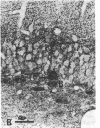Abstract
Antibodies against gamma-aminobutyric acid (GABA)-glutaraldehyde-lysine were obtained by using a procedure based upon (i) a high yield of coupling of GABA to protein carriers, (ii) the reduction of the resulting immunoreactive double bonds, and (iii) a protocol of alternative immunizations using different immunogens having in common only the GABA-glutaraldehyde-lysine segment. This strategy led to the use of the resulting GABA antiserum without further purification. Specificity controls have been carried out with a radiolabeled ligand, [3H]GABA-glutaraldehyde- prolylphenylalanyl -lysine , which mimicked the structure of the immunogen and the fixed hapten in the tissue. Displacement curves showed that the nearest coupled analogs, beta-alanine and glycine, cross-react poorly with GABA, requiring 175-fold or 795-fold higher concentrations, respectively. Immunocytochemical results indicated that the localization obtained with this GABA antiserum largely corresponds with that reported after glutamate decarboxylase immunocytochemistry. The approach may have general applicability to other small molecules such as amino acids.
Full text
PDF




Images in this article
Selected References
These references are in PubMed. This may not be the complete list of references from this article.
- Cailla H. L., Cros G. S., Jolu E. J., Delaage M. A., Depieds R. C. Comparison between rat and rabbit anticyclic AMP antibodies--specificity toward acyl derivatives of cyclic AMP. Anal Biochem. 1973 Dec;56(2):383–393. doi: 10.1016/0003-2697(73)90204-2. [DOI] [PubMed] [Google Scholar]
- Geffard M. R., Puizillout J. J., Delaage M. A. A single radioimmunological assay for serotonin, N-acetylserotonin, 5-methoxytryptamine, and melatonin. J Neurochem. 1982 Nov;39(5):1271–1277. doi: 10.1111/j.1471-4159.1982.tb12565.x. [DOI] [PubMed] [Google Scholar]
- Geffard M., Buijs R. M., Seguela P., Pool C. W., Le Moal M. First demonstration of highly specific and sensitive antibodies against dopamine. Brain Res. 1984 Feb 27;294(1):161–165. doi: 10.1016/0006-8993(84)91323-4. [DOI] [PubMed] [Google Scholar]
- Ribak C. E., Vaughn J. E., Saito K., Barber R., Roberts E. Immunocytochemical localization of glutamate decarboxylase in rat substantia nigra. Brain Res. 1976 Nov 5;116(2):287–298. doi: 10.1016/0006-8993(76)90906-9. [DOI] [PubMed] [Google Scholar]
- Steinbusch H. W., Verhofstad A. A., Joosten H. W. Localization of serotonin in the central nervous system by immunohistochemistry: description of a specific and sensitive technique and some applications. Neuroscience. 1978;3(9):811–819. doi: 10.1016/0306-4522(78)90033-7. [DOI] [PubMed] [Google Scholar]
- Storm-Mathisen J., Leknes A. K., Bore A. T., Vaaland J. L., Edminson P., Haug F. M., Ottersen O. P. First visualization of glutamate and GABA in neurones by immunocytochemistry. Nature. 1983 Feb 10;301(5900):517–520. doi: 10.1038/301517a0. [DOI] [PubMed] [Google Scholar]
- Vaitukaitis J., Robbins J. B., Nieschlag E., Ross G. T. A method for producing specific antisera with small doses of immunogen. J Clin Endocrinol Metab. 1971 Dec;33(6):988–991. doi: 10.1210/jcem-33-6-988. [DOI] [PubMed] [Google Scholar]
- Wu J. Y., Chude O., Wein J., Roberts E., Saito K., Wong E. Distribution and tissue specificity of glutamate decarboxylase (EC 4.1.1.15). J Neurochem. 1978 Apr;30(4):849–857. doi: 10.1111/j.1471-4159.1978.tb10793.x. [DOI] [PubMed] [Google Scholar]






